“How do you fly out of LaGuardia on time? Fly out of JFK instead.”
Until recently, that old joke always landed. Following a nine-year, $8 billion campaign, it hardly rings true. The dark, cramped, and seemingly universally detested Central Terminal that once stood at the heart of LaGuardia Airport has been replaced with a spacious, brighter headhouse: Terminal B. The about-face is all the more remarkable considering the complexities of building in front of, behind, and over existing roadways as well as an active concourse that continued to serve roughly 45,000 daily passengers during the transformation.
“It was a bit like driving down the highway at 60 miles per hour, getting a flat, and having to change the tire without being able to stop the car,” says Peter Ruggiero, design principal at HOK, architect of the 1.3 million-square-foot, 35-gate project.
Despite its recent reputation, LaGuardia’s Central Terminal had been heralded as the “air gateway to America” when it opened in April 1964, 25 years after commercial operations began at the airport. Locals would visit the rooftop observation deck just to watch planes come and go. Its arrival marked an exciting moment in New York history too—down the road, the World’s Fair opened at Flushing Meadows, and the Mets threw their first pitch at Shea Stadium. Harrison & Abramovitz’s no-nonsense, quarter-mile-long building may have lacked the formal niceties of Eero Saarinen’s freshly minted TWA Flight Center at John F. Kennedy International Airport, but it brought LaGuardia into the jet age, along with space for 8 million passengers annually.
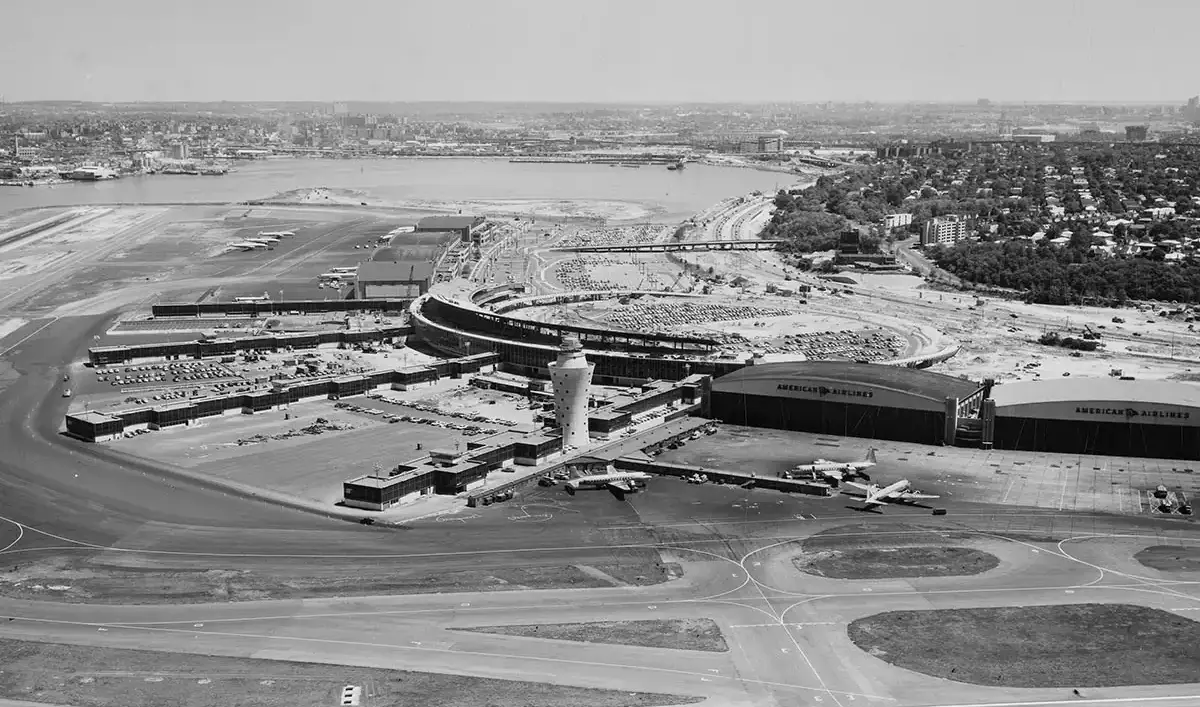
LaGuardia’s Central Terminal opened in April 1964. Photo courtesy of the Queens Borough Public Library, Archives, Chamber of Commerce of the Borough of Queens Collection, click to enlarge.
But times change, as Shea Stadium (now demolished) and the former exposition grounds (which have had their ups and downs) illustrate.
“LaGuardia, like other airports from that era, had difficulty responding to changing needs,” explains Ruggiero. As aircraft incrementally increased in size, airports seemed to shrink, leaving less space for pilots to maneuver on the ground and creating pinch points near jetways. This was especially true at the Central Terminal, where a single setback could cause delays to pile up while engines idled and passenger patience plummeted. New security measures, introduced following a slew of hijackings in the late 1960s and ’70s and especially after the 9/11 attacks, meant bulky screening devices crammed into facilities never designed to accommodate them. “Everyone wants something to blame, but they don’t understand the forces—in the market, in government, and in world events—that really drove airports of this vintage to fail,” he says.
LaGuardia didn’t have much room to spread its wings, either. The same proximity to Midtown Manhattan that first drew officials to the location has been, at times, a crutch—residential neighborhoods surround much of the airport, which is built on filled marshland along Flushing Bay. After additional terminals were erected in 1983 and 1992 (recently reconfigured by Gensler and Corgan into the new Terminal C, operated by Delta), little room remained to expand. To ease congestion, the Port Authority of New York and New Jersey, the interstate agency responsible for overseeing infrastructure in the New York metropolitan region, implemented a six-day-per-week “perimeter rule,” restricting flights from destinations farther than 1,500 miles away (Denver being the only exception).
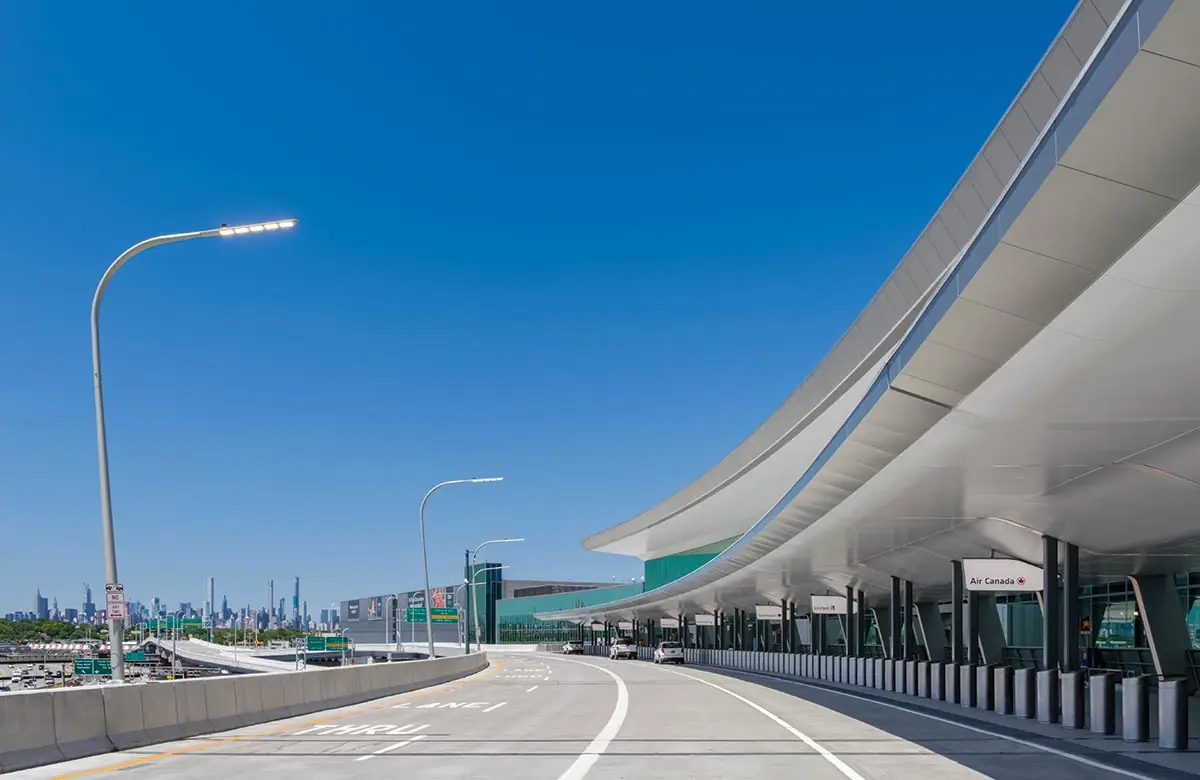
Manhattan is visible from the airport. Photo © Jeff Goldberg
And with two 7,000-foot-long runways, LaGuardia was better suited to smaller, narrow-body aircraft with shorter ranges—making it a go-to hub for commuters and regional business travel. (By comparison, the longest runway at JFK is twice that length, accommodating much larger planes that can travel farther distances.) With quicker turnaround comes more opportunity for schedules to go awry.
During the last year of its full service, the Central Terminal saw nearly 14 million passengers—almost double what it had been designed to support and about half of the airport’s total passenger volume. “LaGuardia Airport was the worst in the country, period,” says Rick Cotton, executive director at the Port Authority. “It was embarrassing, substandard, and out of date.” Americans agreed—in Travel + Leisure magazine’s inaugural airport survey, readers rated the airport dead last.
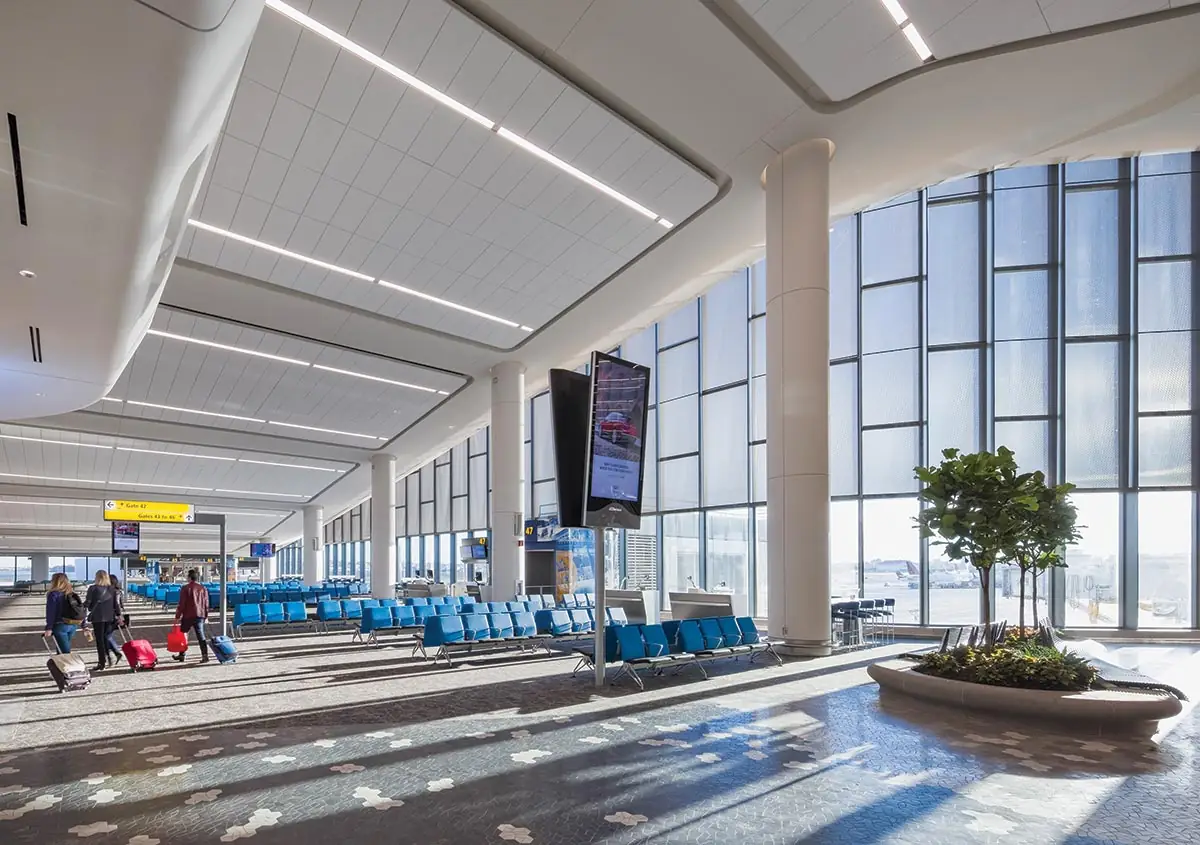
The sloped concourse ceilings maintain sight lines from the ATC tower. Photo © Jeff Goldberg
In 2015, the Port Authority announced a public-private partnership with LaGuardia Gateway Partners (LGP), a consortium comprising Vantage Airport Group, Skanska USA, Meridiam, and JLC Infrastructure, to completely overhaul the Central Terminal. The financing arrangement—valued at $5.1 billion, the largest such partnership in U.S. aviation history—was intended to reduce the burden on taxpayers. “For every dollar of Port Authority capital, there were three dollars of private financing,” says Cotton, who took charge of the agency in 2017. This allowed the public partner to set quality and design standards, he explains, while the private partner brought “efficiency, operational skills, and attention to customer experience. The interplay of those two produces a much better product for the public.”
HOK and engineering partner WSP collaborated closely with the design-build joint venture of Skanska-Walsh to develop an ambitious but implementable scheme: a headhouse would be erected in front of the existing Central Terminal, two island concourses would be built airside, and two bridges would connect the structures—all completed while closing no more than four active gates. The old terminal would then be systematically disassembled. “At times, it led to some strange conditions, where passengers would land, walk through a brand-new concourse, cross a temporary bridge, and then emerge into the old terminal,” recalls HOK president Carl Galioto, “but in the end it worked.”

Indoor gardens, with hexagonal floor patterns echoing the pavers found in New York City parks, offer places to rest. Photo © Jeff Goldberg
Construction began in 2016 with a 3,100-space parking garage west of the Central Terminal, which freed the team to demolish an existing one that, since the 1970s, had become the unsightly public face of the airport. With it gone, the new headhouse began to rise in its place, about 600 feet closer to the Grand Central Parkway, helping HOK echo the civic presence that the Central Terminal once commanded. “The architecture should start as soon as travelers approach from the road,” Ruggiero adds. The team’s work in this regard extended to advising on the redesign of neighboring terminals, helping to create a coherent, unified airport.
At Terminal B, a sweeping 1,200-foot-long glass curtain wall ensures that the interior of the departures and arrivals hall remains bright—in fact, engineers devised a cable-supported facade system that minimized mullion size—and clerestories along the opposite wall balance that brightness. In section, the architects punched through floor plates, bringing daylight to the arrivals level and baggage carousels (so often tucked into the lowest and darkest floors, but here conceived as a mezzanine, with another floor underneath). Partnering with the Public Art Fund, LGP filled the arrivals and departures hall, as well as other spaces, with commissioned artworks too.
After checking in and passing through security, travelers glimpse the not-so-faraway concourses and the soaring pedestrian bridges that will transport them there. Although similar crossings have appeared in other airports—notably, at London’s Gatwick Airport and Denver International Airport—LaGuardia’s Terminal B is the first in the world with two, and the first to use them as an active part of construction phasing. “It’s also a metaphor,” adds Galioto. “New York is a city of islands and bridges.”
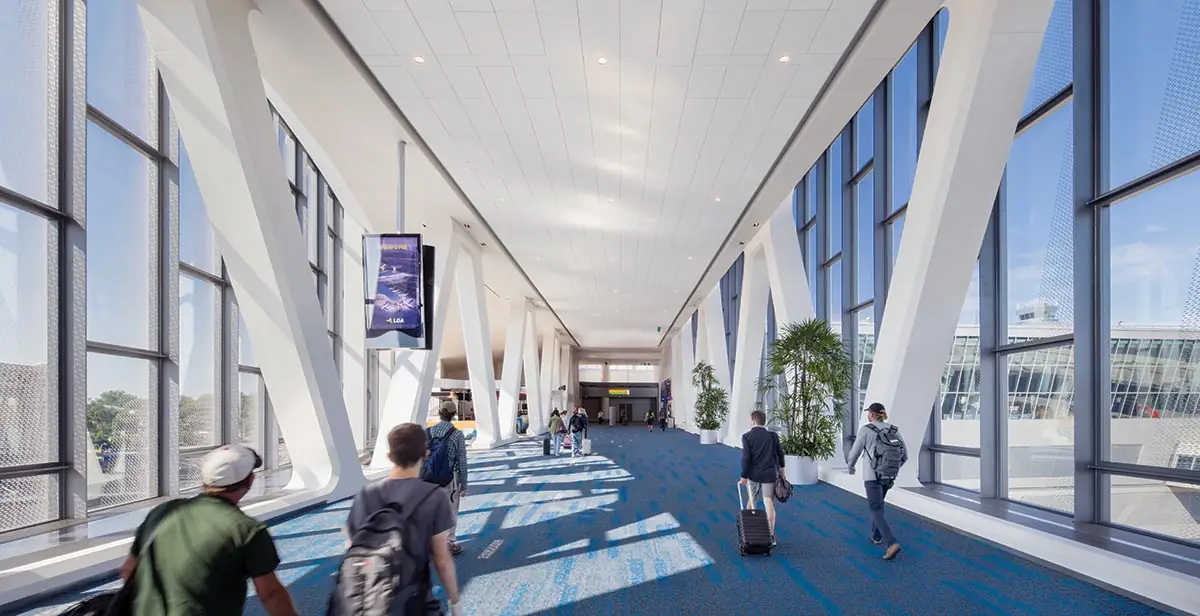
1
Pedestrian bridges (1) were built over the old Central Terminal as part of the construction strategy (2). Photos © Jeff Goldberg

2
During the planning stage, designers needed to sandwich the bridges between two datum lines. Above, visibility from the air-traffic control tower to the apron could not be obstructed (this also led to the concourses’ gently tapered profiles). Below, the bridges needed to hurdle the existing Central Terminal, which, after demolition, would create space for additional taxiways beneath them to improve aircraft circulation. With 57 feet of clearance, there is enough room for a Boeing 767—a rare but occasional visitor at LaGuardia—to pass by.
HOK’s internal engineering team, using parametric software, studied over 100 truss configurations in search of the right balance of transparency, construction feasibility, and cost. Structurally isolated, the bridges flare outward on either end with steelwork that continues to the ground, where they are supported on 150-foot-long piles. And, with each spanning a distance of about two Manhattan blocks, different scenarios—from routine commuter foot traffic to simultaneous, multi-aircraft deplaning—were analyzed to minimize vibration.
After crossing either of the bridges, travelers begin their descent toward the gates. The Terminal B concourses may lack some of the finer material touches—slatted wood ceilings and marble accent walls—that are flaunted next door at Terminal C, but in many respects, the two facilities cannot be compared. One, operated and developed by a single airline, reflects that company’s “brand”; on the other hand, Terminal B, hosting four major airlines, was always intended to be more universal.
When the ribbon was cut at Terminal B in 2022, some questioned the wisdom of its opening during a pandemic that had upended the airline industry. Others wondered why the new facility had the same number of gates as its predecessor, and not more. Air travel has returned—as of December 2023, the airport is on track to eclipse its previous peak of 31.5 million passengers in 2019—and gate numbers alone do not tell the whole story. With common-use jetways and 57 percent more space for passengers in Terminal B, plus an additional two miles of taxiways across the airport, LaGuardia is operating more efficiently. According to the U.S. Department of Transportation, airport-wide flight delays have decreased from 26.62 percent four years ago to 20.75 percent, which translates to a lot of time and energy saved.
The accolades have steadily trickled in as well. Terminal B recently became the first in North America to receive five stars from airline- and airport-rating service Skytrax. “The evolution from worst-in-class to best-in-class is something that we are very proud of,” Cotton says. “It’s not just that the airport is new, but that, as passengers experience the architecture, interior design, public art, and multiple concessions, they recognize that they’re in New York, too.”
Click drawing to enlarge
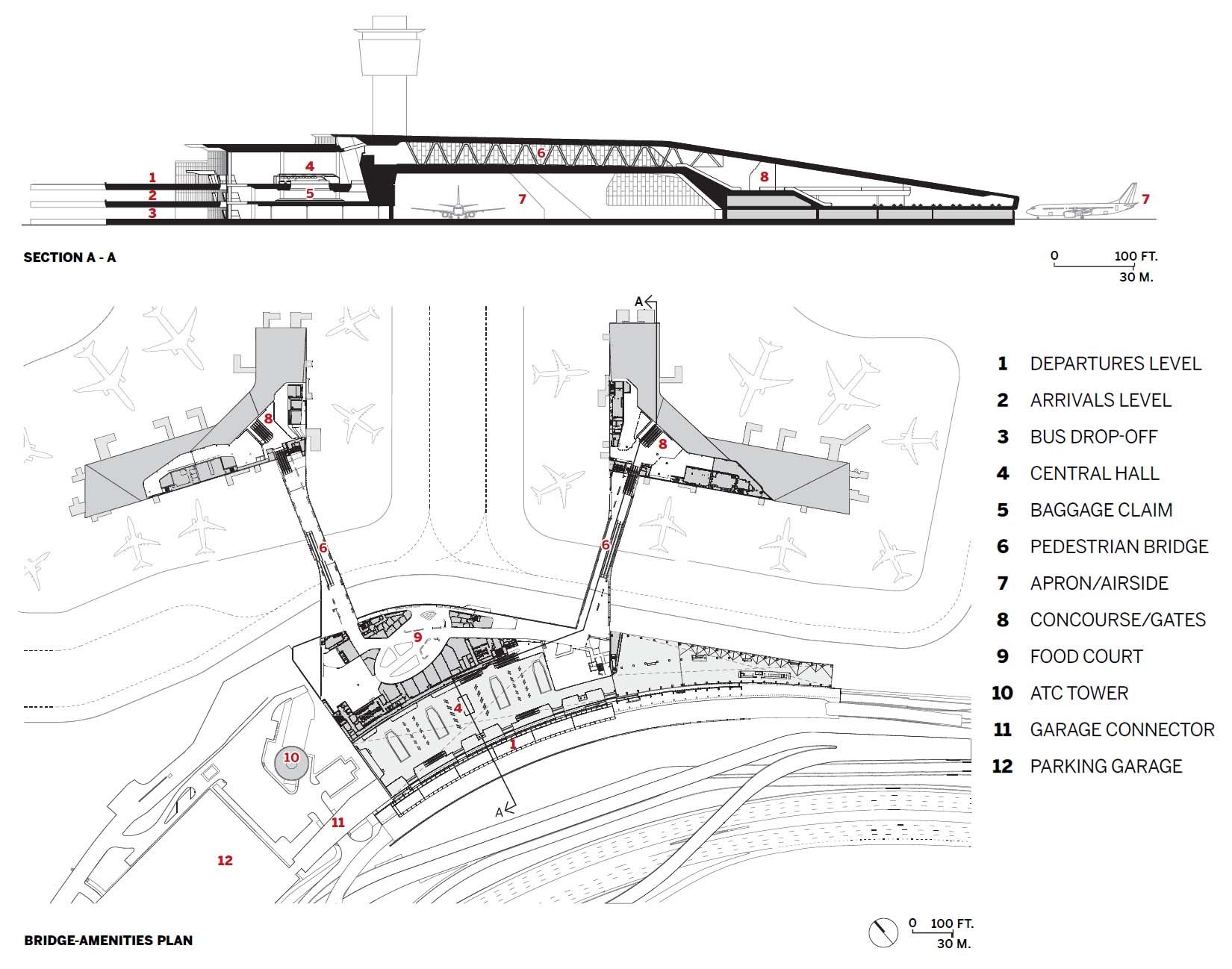
Credits
Architect:
HOK — Carl Galioto, project principal; Peter Ruggiero, lead project designer; Jeannette Segal, senior project designer; Paul Auguste, design manager; Matt Breidenthal, engineer of record; James Christerson, senior project architect; Peter Costanzo, Scott Yocum, project architects; Stephen Weinryb, QA/QC; Stephen Beacham, interiors lead; Eli Hoisington, designer; Francesca Meola, senior engineer
Engineers:
HOK (engineer of record, facades, low voltage, plumbing, structural for bridges and concourses); WSP (m/e/p, civil, geotechnical, structural for parking garage); Arora and Engineers (fire); Thornton Tomasetti (structural)
Consultants:
Vantage Airport Group (operations); Cerami & Associates (acoustics); Cage (baggage); WC3 Design (irrigation); Supermass Studio (landscape); Goldstick Lighting Design (lighting)
General Contractor:
Skanska-Walsh Design-Build Joint Venture
Client:
LaGuardia Gateway Partners
Owner:
Port Authority of New York and New Jersey
Size:
1.3 million square feet
Cost:
$5.1 billion
Completion Date:
January 2023
Sources
Exterior Cladding:
Navillus (masonry); Sobotec (metal panels)
Curtain Wall:
Permasteelisa
Moisture Barrier:
Carlisle Coatings & Waterproofing
Doors:
Nabco; Kawneer (sliding doors); Rytek (rolling doors)
Lighting:
3G Lighting; Pinnacle Architectural Lighting; Architectural Lighting Works; Birchwood Lighting; Cooper Industries; V2; Hubbell Columbia Lighting; Electric Mirror
Conveyance:
Kone
Interior Finishes:
Norton (hardware); Armstrong (acoustical panel ceilings); Modernfold (operable panel partitions); Tarkett (carpet); Dupont (solid surfacing); Scuffmaster (paint)






Post a comment to this article
Report Abusive Comment